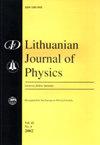Effects of parabolic barrier design for multiple GaAsBi/AlGaAs quantum well structures
IF 0.3
4区 物理与天体物理
Q4 PHYSICS, MULTIDISCIPLINARY
引用次数: 0
Abstract
The results of a comparative study on how the design of multiple quantum structures containing a parabolic barrier profile affects optical properties are presented. All quantum well (QW) structures were grown by molecular beam epitaxy (MBE) on semi-insulating GaAs substrates. The investigated samples consisted of (i) double parabolic quantum wells (type A) or (ii) multiple (two or three) rectangular quantum wells surrounded by parabolic barriers (type B). The optical quality of samples was characterized performing room-temperature (RT-PL) and temperaturedependent photoluminescence (TD-PL) measurements. The investigation aimed at the optimization of a multiple quantum well (MQW) structure design for application in the gain region of near infrared (NIR) laser diodes (LDs) revealed benefits of both double parabolic quantum wells and a mixed design (rectangular MQW with parabolic barriers). The PL band position for all samples was registered in the vicinity around 1.19 eV, which corresponds to the Bi content in QW of ~4.4%. It was shown that all structures of type A exhibit an intense emission, while the intensity of photoluminescence measured for the samples of type B depends on the number of QWs. The weaker intensity of the PL signal from two QWs inserted between parabolic barriers was explained by a larger point defect density at low temperature grown inner GaAs barriers. The room-temperature PL intensity of the structure with three GaAsBi QWs embedded in one parabolic AlGaAs barrier was the highest one. The shift of PL peak position to lower energies (1.16 eV) was attributed to the slightly higher bismuth concentration, 4.9%.多砷化镓铋/砷化镓量子阱结构抛物线势垒设计的影响
本文介绍了一项比较研究的结果,该研究探讨了含有抛物线势垒轮廓的多重量子结构的设计如何影响光学特性。所有量子阱 (QW) 结构都是通过分子束外延 (MBE) 技术在半绝缘砷化镓基底上生长的。所研究的样品包括 (i) 双抛物线量子阱(A 型)或 (ii) 抛物线势垒环绕的多个(两个或三个)矩形量子阱(B 型)。通过室温(RT-PL)和随温度变化的光致发光(TD-PL)测量,对样品的光学质量进行了表征。这项旨在优化多量子阱(MQW)结构设计以应用于近红外(NIR)激光二极管(LD)增益区的研究发现了双抛物线量子阱和混合设计(带有抛物线势垒的矩形 MQW)的优点。所有样品的 PL 带位置都在 1.19 eV 附近,这与 QW 中约 4.4% 的铋含量相对应。结果表明,所有 A 型结构都表现出强烈的发射,而 B 型样品的光致发光强度则取决于 QW 的数量。插入抛物线势垒之间的两个 QW 的 PL 信号强度较弱,这是因为在低温生长的 GaAs 内部势垒的点缺陷密度较大。三个 GaAsBi QW 嵌入一个抛物面 AlGaAs 势垒的结构的室温 PL 强度最高。由于铋浓度略高(4.9%),PL 峰位置向较低能量(1.16 eV)移动。
本文章由计算机程序翻译,如有差异,请以英文原文为准。
求助全文
约1分钟内获得全文
求助全文
来源期刊

Lithuanian Journal of Physics
物理-物理:综合
CiteScore
0.90
自引率
16.70%
发文量
21
审稿时长
>12 weeks
期刊介绍:
The main aim of the Lithuanian Journal of Physics is to reflect the most recent advances in various fields of theoretical, experimental, and applied physics, including: mathematical and computational physics; subatomic physics; atoms and molecules; chemical physics; electrodynamics and wave processes; nonlinear and coherent optics; spectroscopy.
 求助内容:
求助内容: 应助结果提醒方式:
应助结果提醒方式:


